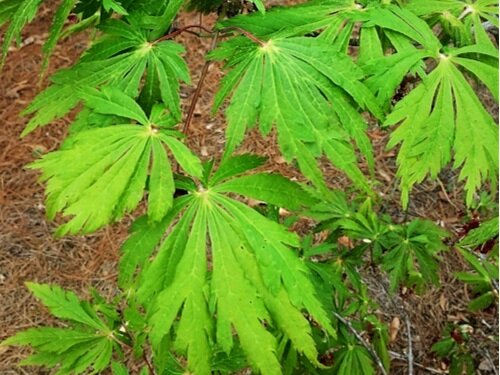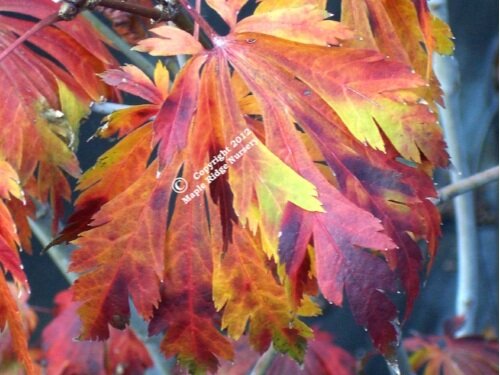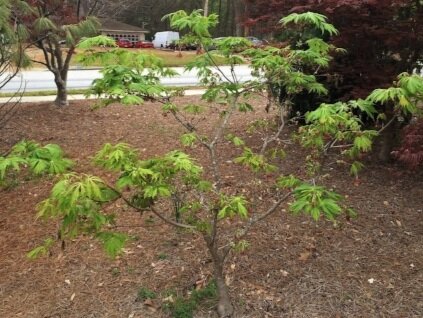Acer japonicum ‘Aconitifolium’



Description:
‘Aconitifolium’ has been known by many names like, Fernleaf Maple, Maiku jaku or Dancing Peacock this plant is a real crowd pleaser no-matter what you call it. A small to medium size tree ‘Aconitifolium’ can be a little slow growing in the south and benefits from a little afternoon shade. More upright when young ‘Aconitifolium' eventually forms an elegant round topped tree that is more broad than tall. Fall color is awesomely brilliant red, with yellow and orange all on its very large leaves.
10 Year Size:
Height: 8-10 Feet Width: 6-8 Feet
Acer japonicum ‘Aconitifolium’ will grow to be a small upright tree over time. While it can eventually get some good height to it, it is never going to be a tree that overpowers a landscape.
The width of Aconitifolium will naturally expand to about 6 or 8 feet wide in ten years without any intervention. However, Aconitifolium can be easily trained by pruning to maintain a smaller width.
COLORS:
Acer japonicum ‘Aconitifolium’ emerges in spring with large, light green leaves. These leaves will darken as the temperatures get hotter. Leaves will stay lighter in more sun. Fall is when this Japanese maple tree really puts on a show. Fall colors can range from yellow to orange to red. This array of colors can be splashed all over the foliage of Aconitifolium at the same time during the fall.
STRUCTURE:
Acer japonicum ‘Aconitifolium’ has a typical structure for an Acer japonicum. Acer japonicums are known for their large, stiff stems and large leaves. The branches will often have long lengths between leaves giving Aconitifolium an elegant open habit.
HISTORY:
Acer japonicum ‘Aconitifolium’ is an old cultivar from Japan that goes by many names. It is often referred to as ‘Dancing Peacock’, ‘Mai kujaku’, or even the Fern leaf Japanese maple. As an Acer japonicum, ‘Aconitifolium’ is a Full Moon Japanese maple and is sometimes referred to as Full Moon as well. No matter what you call it, ‘Aconitifolium’ is a fantastic Japanese maple worth having in any landscape. Acer japonicum ‘Aconitifolium’ won the Royal Horticultural Society’s Award of Garden Merit in 1993.
HARDINESS:
USDA Plant Hardiness Zones: 5-9
AHS Heat Zone: 5-10
Sunset Climate Zone: 3-10, 12, 14-24, 28-37
Japanese maples such as Acer japonicum ‘Aconitifolium’ are hardy in most regions of the United States. The only areas where they will not work are areas of extreme cold or extreme hot temperatures. Areas of extremely high altitudes may also not work particularly well for Japanese maples. Japanese maples will also thrive better in areas of consistent rainfall. These zones are general rules, but exceptions do apply. Do your own research on your particular area before purchasing a Japanese maple, but Japanese maples are generally a very hardy tree.
SUN TOLERANCE:
The majority of Japanese maples are going to prefer some variation of morning sun and afternoon shade. While this is great in a perfect world, it is not realistic for every Japanese maple. Many Japanese maples can handle much more sun, such as Acer japonicum ‘Aconitifolium’. Aconitifolium can handle up to all day sun with little issues. However, better color will be maintained in the summer if given a break from the hot afternoon sun.
PLANTING:
Planting A Japanese Maple In The Ground:
All Japanese maples should be planted slightly elevated on a mound. This can be done by leaving a small portion of the rootball above ground level when planting. Dirt is then brought up to the sides covering up the majority of the roots. The end result is an elevated mound up to the base of the tree. The root flare where the trunk ends and the roots begin should be visible above ground level when planting is finished. A light layer of pine straw or pine bark mulch around the tree is all the mulch that is needed for a Japanese maple. Don’t pile too much mulch up against the trunk of the tree.
Planting A Japanese Maple In A Container:
Japanese maples like Aconitifolium work great as container plants. When planting a Japanese maple in a container, we typically recommend a 50/50 mix of soil conditioner and potting soil. This will provide a good growing medium for your tree while also allowing for proper drainage. You still want to plant your Japanese maple slightly elevated in the container with the root flare above the dirt level.
SOIL REQUIREMENTS:
Japanese maples like Acer japonicum ‘Aconitifolium’ prefer slightly acidic soils, but they are very adaptable to nearly any soil. We rarely recommend any soil amendments when planting a new Japanese maple other than possibly some soil conditioner or top soil to fill in here and there. The main thing to consider with soil is the drainage. Japanese maples love well draining soil. They like to get wet, but they don’t like to stay wet. This is another reason that we recommend planting Japanese maples elevated on a mound, so that the water can drain out from the roots of the Japanese maple tree.
WATERING:
Japanese maples like moist well draining conditions. They like good soakings, but then that water needs a chance to drain away. Japanese maples do not like wet feet. When you first plant your Aconitifolium, you should water no more than once or twice per week depending on the time of the year. Your Aconitifolium Japanese maple may need more water when planted in the summer versus if it is planted in the fall or winter. After a couple of months you can back off on the watering a little bit as the tree is getting established. There is no need to water your Aconitifolium while it is dormant unless there is no rain for several weeks. Your Aconitifolium should be able to live off of nothing but rain water after the first year in the ground. You can give it a drink again if there hasn’t been any rain for a couple weeks or so. Important: most people have more issues overwatering their Japanese maple than under watering it. Don’t kill your Japanese maple tree with kindness.
SPECIAL CARE:
There is very little special care required with Japanese maples, including Acer japonicum ‘Aconitifolium’ You want to fertilize your Japanese maple in the spring with an organic Japanese maple fertilizer such as Happy Frog. This will ensure that your Aconitifolium Japanese maple is receiving all the nutrients it needs to flourish in your yard.
PRUNING:
You can prune your Aconitifolium Japanese maple in the winter when the tree is dormant. This is the best time to prune a Japanese maple because the energy of the tree is not flowing as actively as it may in the spring or summer. Aconifitifolium takes very well to pruning and can become an elegant tree over time with proper care. There are many different ways to prune a Japanese maple. As long as you only prune in the winter and never take more than a third of the tree off at any given time, then it is hard to go wrong. Pruning is all about your personal preferences and making your tree look good for you.

